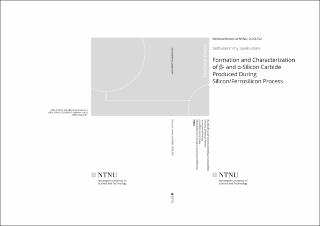| dc.description.abstract | Silicon carbide (SiC) is one of the main intermediate compounds generated during primary silicon (Si) production in submerged arc furnaces. Carbon materials, either biomass-based (charcoal and wood chips) or based on fossil sources (coal, coke, and petroleum coke) are the primary reduction materials for Si production. The interaction between carbon materials and silicon monoxide gas (SiO(g)) to form SiC is vital in this process. SiC exists as many forms of polytypes, and the most common forms of SiC prevailing at atmospheric pressure are the α-SiC and β-SiC. SiC is also observed during industrial excavations, accumulated in the form of crust in the high-temperature zones of the furnaces. Macroscopic and microscopic characterizations of these SiC samples have revealed that carbon materials added to the process initially transform to β-SiC at lower temperatures, and would further transform to α-SiC at temperatures ≥ 2000 °C. This thesis investigates the material structures and physical properties of SiC formed from industrial carbon materials (charcoal, coal, and petroleum coke), at temperatures ranging from 1674 to 2450 °C.
To study the production and properties of β-SiC formed from these carbon materials, a laboratory-scale experimental method was developed, simulating the industrial process. An induction furnace was used to produce β-SiC using charcoal, coal, and petroleum coke. Two different SiO(g) sources such as (SiO2 + Si) and (SiO2 + SiC), giving various SiO pressures, were also explored in this study. Experiments were performed at temperature ranges of 1674–1900 °C and the SiC samples produced at this temperature range were confirmed as β-SiC by the X-ray diffraction analyses. The formation of β-SiC is more efficient with charcoal, followed by coal and petroleum coke. This shows that besides the temperature, the physical properties of carbon materials such as porosity and cell wall thickness also determine the SiO(g) reactivity. Charcoal has a higher porosity and thinner cell walls compared with coal and petroleum coke. Also, more SiC was produced with the higher SiO pressure obtained by using (SiO2 + Si) as the source for SiO(g).
Elemental silicon was produced in the SiC structures at higher SiO pressures and higher temperatures. Thermodynamic calculations show that Si production is possible only at a temperature above 1800 °C. In this work, the production of elemental Si in SiC particles was observed even at 1674 °C, at higher SiO pressures. This shows that the gas phase will not be in equilibrium with the condensation products. The formation of Si in SiC particles increased with an increase in temperature. The current findings indicate that it is possible to produce Si in SiC particles quite high up in the furnace at lower temperatures (< 1800 °C), provided the partial pressure of SiO(g) is favorable.
Microscopic analyses revealed that SiC forms through two different mechanisms; (a) SiC surface crystals of varying sizes and shapes form on the pore wall surfaces, and (b) the carbon pore walls themselves transform to SiC. The SiC surface crystals form via the gas phase mechanism, where SiO(g) reacts with CO(g); whereas the pore walls transform to SiC as the diffused SiO(g) reacts with the solid carbon.
Morphological characterization of SiC particles formed from charcoal at a temperature around 1750 °C showed that SiC surface crystals in the shape of ‘micro-bullets’ grew on their surfaces either as solitary crystals or in clusters forming micro-bullet “flowers”. Interestingly, such bullet-shaped SiC crystals were observed only on the charcoal substrates. This suggests that the carbon material properties as well as the local reaction conditions might control the morphology. The SiC lamella extracted from the bullet-shaped crystals had a high density of stacking faults in a non-periodic manner. However, it is noteworthy that despite the high stacking fault density, the sizes and morphologies of the micro-bullets are relatively homogeneous. The findings are relevant in the field of SiC ceramics from bio-carbon for the development of novel light-weight high-temperature-resistant materials. The SiC surface crystals formed on coal and petroleum coke were different from those formed on charcoal. SiC crystals in coal were long thick nanowires and whiskers, whereas, in petroleum coke, they were mostly whiskers.
The Shrinking Core Model (SCM) closely approximated the real particles in charcoal. The charcoal partly converted to SiC showed a sharp boundary between the SiC product layer and the unreacted carbon in the middle. However, coal and petroleum coke used in this study behaved differently, they did not follow the SCM mechanism. In coal particles, the SiC formed was more spatially distributed and in petroleum coke a sharp boundary was clearly visible between the pore walls that had transformed to SiC and the unreacted region.
β-SiC with elemental Si of varying amounts, produced by the original carbon materials were utilized for studying the transformation of β-SiC to α-SiC. A graphite tube furnace efficient for high-temperature experiments was utilized for the heat-treatment of β-SiC particles at temperatures ranging from 2100 to 2450 °C. Results showed that the transformation to α-SiC was greatly influenced by the original carbon source. Charcoal-converted β-SiC particles easily transformed to α-SiC at 2100 °C, compared with β-SiC from coal and petroleum coke. Moreover, the amount of elemental Si in SiC particles enhanced the transformation to α-SiC at 2100 °C.
Based on this work, the following conceptual model for the industrial furnace could be discussed: β-SiC would form when carbon reacts with SiO(g), both through solid-gas reaction and gas phase. Once the β-SiC is formed, elemental Si would easily form in the SiC particles at temperatures lower than the theoretical Si production temperature. The β-SiC transforms to α-SiC at higher temperatures (≥ 2000 °C). Carbon material properties as well as the amount of elemental Si in β-SiC particles influence the transformation of β-SiC to α-SiC. | en_US |
